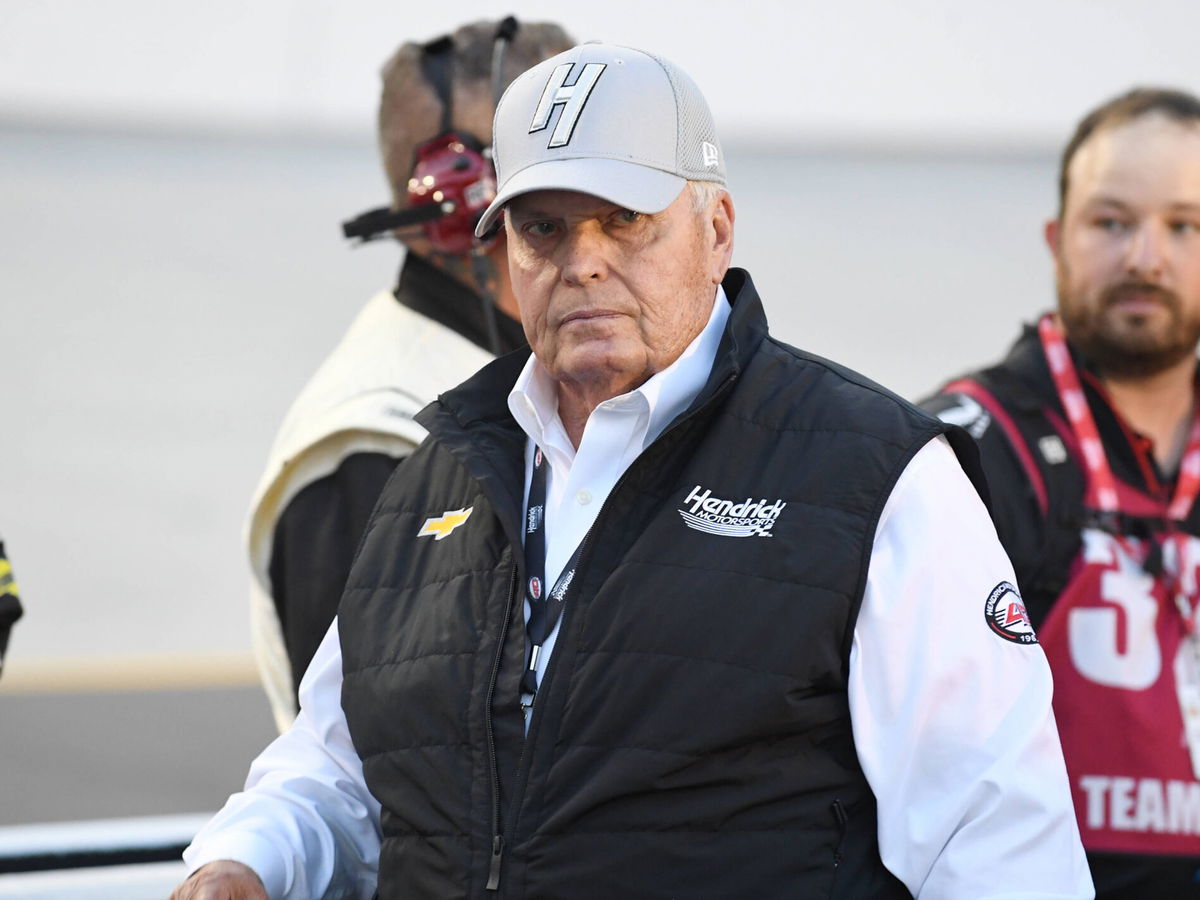
Imago
BRISTOL, TN – SEPTEMBER 21: Rick Hendrick looks on prior to the running of the NASCAR, Motorsport, USA Cup Series Bass Pro Shops Night Race on September 21, 2024, at Bristol Motor Speedway in Bristol, TN. Photo by Jeffrey Vest/Icon Sportswire AUTO: SEP 21 NASCAR Cup Series Bass Pro Shops Night Race EDITORIAL USE ONLY Icon240921905

Imago
BRISTOL, TN – SEPTEMBER 21: Rick Hendrick looks on prior to the running of the NASCAR, Motorsport, USA Cup Series Bass Pro Shops Night Race on September 21, 2024, at Bristol Motor Speedway in Bristol, TN. Photo by Jeffrey Vest/Icon Sportswire AUTO: SEP 21 NASCAR Cup Series Bass Pro Shops Night Race EDITORIAL USE ONLY Icon240921905
Rick Hendrick has built an empire in NASCAR, leading Hendrick Motorsports to 14 Cup Series championships since founding the team in 1984. As a billionaire car dealership magnate, his decisions often shape the sport’s landscape, blending business savvy with racing passion. Yet, his latest move has stirred deep emotions among fans who cherish the underdog stories that define NASCAR’s history.
Watch What’s Trending Now!
That’s where Alan Kulwicki comes in. The 1992 Cup champion embodied the spirit of an independent owner-driver with a mechanical engineering degree, clinching the title by just 10 points in a dramatic Atlanta finale. “The 1992 Hooters 500 at Atlanta Motor Speedway is widely regarded as one of the most significant moments in NASCAR history,” said Winston Kelley, Executive Director of the NASCAR Hall of Fame. Kulwicki’s Concord shop, established in 1986 after taking over Bill Terry’s operation, became a symbol of grit, where he managed everything from car building to strategy. But now, Hendrick’s involvement in his legacy has sparked some fan accusations of tarnishing his legacy.
Reports indicate that Hendrick Motorsports has acquired Alan Kulwicki’s historic Concord shop from Spire Motorsports, rebranding it under Hendrick Performance for luxury and high-performance car sales. This shift from a racing hub to a dealership has fans questioning the preservation of Kulwicki’s legacy, as the shop, once home to his championship-winning efforts, now displays exotic vehicles instead of race cars. As one Reddit post stated, “Hendrick appears to have purchased the former Kulwicki shop from Spire,” highlighting the surprise amid no official confirmation from either team.
ADVERTISEMENT
Looks like Hendrick bought the old Kulwicki shop pic.twitter.com/Zz107SCdjW
— Davis Warren (@daviswarren) September 2, 2025
Kulwicki‘s legacy centers on his self-made success, winning five Cup races and 24 poles as an underdog against powerhouses, all orchestrated from that modest facility where innovation thrived on a shoestring budget. Spire, who revived the shop in 2021 for their No. 7 team to honor Kulwicki’s No. 7 car, likely sold it to streamline operations and invest in contention-building, given their noted facility limitations. Hendrick’s purchase aligns with expanding his automotive empire, but it raises concerns over erasing a piece of NASCAR’s independent era, much like when Geoff Bodine bought the team post-Kulwicki’s 1993 death to keep the spirit alive.
ADVERTISEMENT
While the deal remains unconfirmed, the backlash among fans underscores the tension between progress and preserving history, setting the stage for passionate fan debates.
ADVERTISEMENT
Fan backlash heats up
One fan expressed fury, saying, “I am going to be irate if Kulwikis shop becomes a luxury car dealership. Would be such a slap in the face to his legacy.” This sentiment captures the pain of seeing a site tied to Kulwicki’s 1992 triumph, where he outsmarted rivals like Bill Elliott for the closest points finish then, transformed into a sales floor for high-end cars. Fans recall how Kulwicki, starting with minimal resources after moving to North Carolina, turned the shop into a beacon of determination, a far cry from today’s corporate setups.
Another commenter joked about the situation. They said, “Dammit Hocevar, see what messing with Chase on Sunday has done?!” tying the sale to recent on-track drama between Spire’s Carson Hocevar and Hendrick’s Chase Elliott at Darlington. This lighthearted jab reflects underlying rivalries, as Spire’s growth ambitions may have prompted unloading the historic property, while Hendrick’s dominance, boasting 305 Cup wins, fuels perceptions of overreach in off-track dealings.
One user spoke about their personal connection to the shop. “I spent a lot of time in that shop growing up. I remember in the paint booth there was still orange paint splatter from the Kulwicki days. Sad for me to see this as a Hendrick Performance and not a race shop anymore.” This evokes nostalgia for the shop’s role in Kulwicki’s era, where orange accents from his Hooters sponsorship lingered as relics, now overshadowed by Hendrick’s pivot to serving elite car enthusiasts rather than fostering grassroots racing.
ADVERTISEMENT
“Now wait, am I supposed to be upset at this or not? I just want to make sure we are giving it the same energy we gave Teresa last month.” This comment by another user points to parallels with Teresa Earnhardt’s handling of Dale Earnhardt‘s legacy, urging fans to scrutinize how icons’ histories are managed, especially as Kulwicki’s Hall of Fame induction in 2019 amplified calls to protect his independent ethos.
Finally, optimism emerged in too, when one fan said, “They do run the track attack program out of there now as well. still would be minor R&D, I bet, along with the luxury car dealer.” This acknowledges Hendrick’s potential to blend heritage with modern uses, like performance programs, echoing how the shop evolved under owners post-Kulwicki’s tragic plane crash, yet maintaining some racing connection amid the commercial shift.
ADVERTISEMENT
ADVERTISEMENT
ADVERTISEMENT

